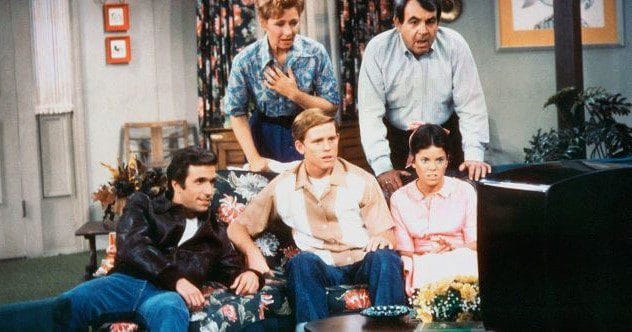Remember the family sitcom? Maybe a little cheesy, sometimes a bit idealized, but often full of heart. In today’s vast TV landscape, shows genuinely celebrating traditional family dynamics can feel rare. Many modern hits depict fractured families or rely on making parents, especially dads, look foolish for laughs.
But it wasn’t always this way! Let’s take a trip down memory lane and revisit ten TV shows that, in their own unique ways, put family first. Here are ten refreshingly pro-family TV shows, presented in chronological order, that remind us of the enduring power of family bonds.
Leave It to Beaver (1957–1963)
The Cleavers basically wrote the playbook for family sitcoms. Arriving in 1957, as suburbia boomed across America, Leave It to Beaver perfectly captured the spirit of the time. The show presented the American Dream with Ward, June, Wally, and ‘the Beaver’ living in their comfortable suburban home.
What made it special was its child’s-eye view of the world. Young Theodore “Beaver” Cleaver navigated school, chores, and playtime mishaps. Usually, an episode involved Beaver finding trouble and facing his parents. Importantly, Ward and June weren’t perfect. They debated parenting, made mistakes, and admitted them – setting a great example. They were a perfectly imperfect family figuring things out, reflecting the experiences of many American families at the time.
The Jetsons (1962–1963)
Finding a positive family portrayal in cartoons can be tough these days. But journey back 60 years – to the future! – and you’ll find The Jetsons. Despite the flying cars and robot maids, this show, set in 2062, was all about familiar family values.
The catchy theme song introduces George, Jane, daughter Judy, his boy Elroy, and their dog Astro. George works a typical job (at Spacely Sprockets), deals with a demanding boss, worries about his teenage daughter, and encourages his son to do well in school. Even with futuristic gadgets, the core message remained: family life and its values stay constant, no matter the era.
The Munsters & The Addams Family (1964–1966)
Imagine the pitch: “They’re creepy and kooky, mysterious and spooky… but deep down, they’re a normal loving family!” That’s the core idea behind both The Munsters and The Addams Family, which surprisingly debuted the same year and ran for two seasons each.
In the early ’60s, gimmick-based sitcoms were popular. These shows used their quirky premises for humor. Instead of just one odd character, these featured entire families who were hilariously out of step with society. The humor came from the contrast between their ‘normal’ (for them) lives and how the outside world reacted. Underneath the monstrous exteriors and morbid fascinations, both families showed genuine affection. Gomez and Morticia Addams were passionately in love, while Herman Munster was a kind, if clumsy, head of the household. Their weirdness bonded them.
Happy Days (1974–1984)
Happy Days brought 1950s nostalgia to the 1970s. Set in Milwaukee, the show initially focused on teenager Richie Cunningham and his wholesome family: hardware store owner Howard, homemaker Marion, and sister Joanie (plus brother Chuck, who famously vanished after season two).
While Arthur “Fonzie” Fonzarelli eventually became the breakout star, the show worked best when contrasting Fonzie’s cool persona with the warmth of the Cunningham family. Fonzie’s leather jacket and rebellious attitude provided laughs, but the Cunninghams offered the heart. The show stumbled when it moved away from its family core, proving that even The Fonz needed the grounding influence of a loving family unit.
Family Ties (1982–1989)
This 1980s hit flipped the script on teenage rebellion. Former hippie parents Steven and Elyse Keaton raised kids who embraced the Reagan era. Eldest son Alex P. Keaton (a star-making role for Michael J. Fox) was a staunch young Republican, a complete contrast to his parents’ liberal ideals. His sister Mallory focused on fashion and materialism, another form of ‘rebellion’ against their simple-living parents.
The show’s genius lay in its portrayal of family love transcending deep political and generational divides. Despite their differing worldviews, the Keatons debated and disagreed under the umbrella of an unbreakable family bond. Michael J. Fox’s charm made Alex lovable despite his conservative rigidity, highlighting that family connections matter more than differing opinions.
The Cosby Show (1984–1992)
It’s impossible to discuss influential family sitcoms without mentioning The Cosby Show, despite the real-life controversies surrounding its star. The show itself remains a landmark television program known for its humor and warmth.
It broke ground by featuring an affluent, educated Black family – Dr. Heathcliff Huxtable and lawyer Clair Huxtable raising their five children in a Brooklyn brownstone. This positive portrayal resonated widely. With financial worries off the table, the show explored universal family issues like sibling rivalry, school challenges (like dyslexia), and navigating adolescence. Clair Huxtable was also a significant character, portraying a successful working mother balancing career and family life effectively, thanks partly to Cliff’s home-based office.
The Wonder Years (1988–1993)
Told through the nostalgic lens of adult Kevin Arnold looking back on his childhood, The Wonder Years was a heartfelt tribute to suburban family life in the late 1960s and early 70s. The show’s grainy, home-movie-style opening set the sentimental tone perfectly.
Living in an unnamed suburb, the Arnolds were a typical family navigating the era’s changes. Kevin’s dad, Jack, was a gruff but loving provider, while his mom, Norma, was the quintessential doting homemaker. Kevin dealt with his bullying older brother Wayne and hippie older sister Karen. Despite the everyday struggles and generational differences, the show emphasized the underlying love and support within the family. Kevin’s narration highlights that, looking back, these seemingly ordinary years rooted in family were truly wondrous.
Roseanne (1988–1997, 2018)
Roseanne offered a groundbreaking, realistic portrayal of a blue-collar family struggling to make ends meet. Premiering in 1988, the Conners stood out starkly against the often-idealized families dominating sitcoms. Roseanne and Dan were overweight, their kids were awkward, and their house wasn’t perfect – they felt real.
The show masterfully blended laugh-out-loud humor with the harsh realities of working-class life. The jokes weren’t just gags; they were coping mechanisms for stress, bills, and demanding jobs. Beneath the sarcastic banter and pranks, the deep love Dan and Roseanne had for each other and their children was undeniable. Family was their refuge, the reason they worked so hard. It was comedy with purpose, showing that strong family bonds could thrive even amid financial hardship.
Home Improvement (1991–1999)
While the ’90s saw a decline in traditional family sitcoms, Home Improvement was a massive hit. Set in Detroit, it centered on Tim “The Tool Man” Taylor, host of a local cable show, his wife Jill, and their three sons.
The show cleverly used the “show within a show” format. On ‘Tool Time’, Tim was often a klutzy, accident-prone caricature. But at home, while still prone to mishaps and obsessed with ‘more power’, he was portrayed as a loving husband and involved father, equal to Jill. This allowed for dad-related humor without making him a complete buffoon. The all-boy household provided plenty of Jags and physical comedy, with Tim often caught between being a referee and joining the mischief, showing a relatable, energetic family dynamic.
Big Love (2006–2011)
Perhaps a surprising entry, HBO’s drama Big Love explored the lives of Bill Henrickson, a Utah businessman secretly practicing polygamy with his three wives and many children. While the premise is unconventional, the show delves deeply into family dynamics in a compelling way.
Instead of depicting a fringe compound, the Henricksons lived in adjacent suburban homes, hiding their lifestyle from mainstream Mormon society. The show wasn’t trying to endorse polygamy but rather illustrated how traditional family values – love, support, shared responsibilities, raising children – could exist within a non-traditional structure. Bill was the provider, the wives managed their households, and they functioned as a large, complex family unit. Crucially, the wives (Barb, Nicki, and Margene) had agency and genuine, albeit complicated, relationships with each other, showcasing a unique, large-scale family love.
Conclusion
From the idealized ’50s suburbs to unconventional modern arrangements, these shows, each in their own era and style, put family front and center. They remind us that whether through laughter, shared struggles, or navigating changing times, the bonds of family provide a powerful anchor. While television continues to evolve, the appeal of stories celebrating connection and love within a family endures.
What are some of your favorite pro-family TV shows? Did we miss any classics? Share your thoughts in the comments below!










